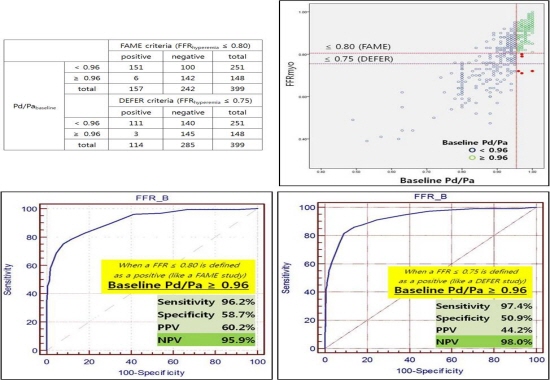| єя«•«ьљƒ : ±Єњђ
|
ЅҐЉцєш»£ - 540555 41 |
| New Perspective on the Fractional Flow Reserve: High Predictive Value of Baseline Pd/Pa during Intracoronary Pressure Wire Study |
| мЦСмВ∞лґАмВ∞лМАнХЩкµРл≥СмЫР мИЬнЩШкЄ∞лВік≥Љ |
| кєАм†ХмИШ, м†Дкµ≠мІД, кєАм§АнЩН, кєАм§А, л∞ХмЪ©нШД, мЖ°мД±кµ≠, нХЬлПЩм≤† |
Objective
Fractional flow reserve tests using intracoronary pressure wire are widely used in practice for the assessment of the significance of coronary artery disease. We investigate the meaning of a baseline Pd/Pa during FFR study.
Methods and Materials
We analyzed the 399 consecutive intracoronary pressure wire study data performed in our hospital using a 'Radi' system for a couple of years. Predictive values of baseline Pd/Pa were calculated by FFR measured after maximal hyperemia. We defined FFR value as positive if FFRhyperemia вЙ§ 0.80 (as in the FAME study) and/or вЙ§ 0.75 (as in the DEFER study).
Results
A total of 399 studies, 157 (39.3%) were positive when the FAME study criteria was applied and 114 (28.6%) were positive when the DEFER study criteria was applied. A baseline Pd/Pa вЙ• 0.96 has a 95.9% ( of negative predictive value (NPV) and a 60.2% of positive predictive value (PPV) when a FFRhyperemia вЙ§ 0.80 is defined as a positive (as in the FAME study). And a baseline Pd/Pa вЙ• 0.96 has a 98.0% of NPV and a 44.2% of PPV when a FFRhyperemia вЙ§ 0.75 is defined as a positive (as in the DEFER study).
Conclusion
We found that baseline Pd/Pa вЙ• 0.96 has very high NPV based on either FAME or DEFER criteria. These results would give a important massage that we do not need to induce hyperemia during intracoronary pressure wire study if baseline Pd/Pa is вЙ• 0.96 in most cases.
|
|
|
Warning: getimagesize(/home/virtual/circulationadmin/renewal/econgress/conference/abstract/img_files/Resize_FFR.jpg) [function.getimagesize]: failed to open stream: No such file or directory in /home/virtual/circulationadmin/new/econgress/conference/manage/schedule/view_abstract.php on line 164

|
|





